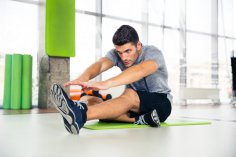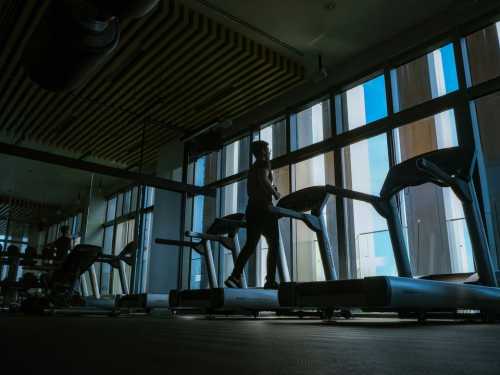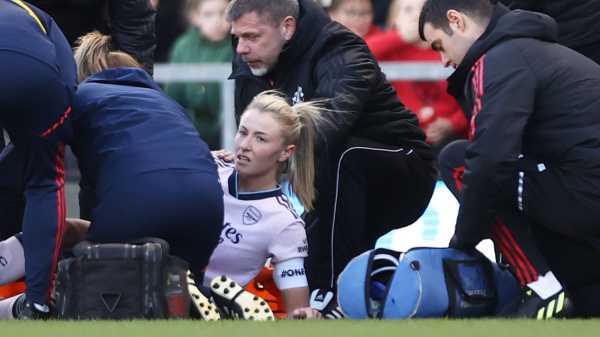
England captain Leah Williamson is the latest WSL player to suffer an anterior cruciate ligament injury. But why is the problem so much more common in the women’s game?
Williamson will now miss the World Cup after rupturing her ACL 12 minutes into Arsenal’s defeat to Manchester United in the WSL earlier this month. Two of Williamson’s team-mates, Beth Mead and Vivianne Miedema, both suffered the same injury this season and are expected to be out until the next campaign.
- Why are ACL injuries so common in women’s football?
- Leah Williamson confirms ‘World Cup dream is over’ after rupturing ACL
- Sarina Wiegman: Beth Mead not in World Cup plans
- Get Sky Sports | Download the Sky Sports App
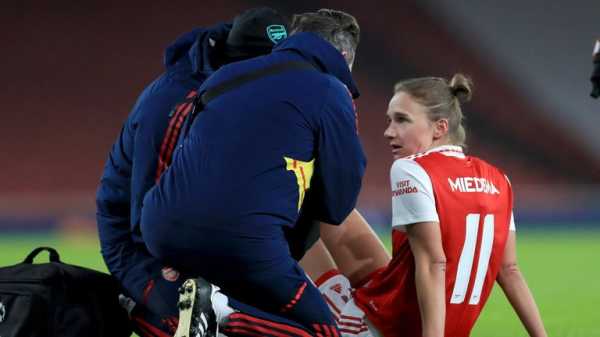
Image: Arsenal striker Vivianne Miedema has been ruled out for the rest of the season with a knee injury
The problem isn’t exclusive to the WSL, either. Ballon d’Or winner Alexia Putellas missed the Euros after rupturing her ACL just days before Spain’s opening game last summer. France striker Marie-Antoinette Katoto and Northern Ireland’s Simone Magill suffered a similar fate once the tournament had got under way.

A host of professionals discuss the difficulties of dealing with and recovering from an ACL injury. Plus, Gary Lewin, head of female performance services at Arsenal, explains the science behind the potentially career-threatening injury
Female footballers are up to six times more likely to suffer an ACL injury than their male counterparts, but we know very little about why due to a lack of research into the matter. Sky Sports News senior reporter Geraint Hughes has sat down with consultant orthopaedic surgeon Nev Davies to find out what’s going on…
What is an ACL and what does it do?
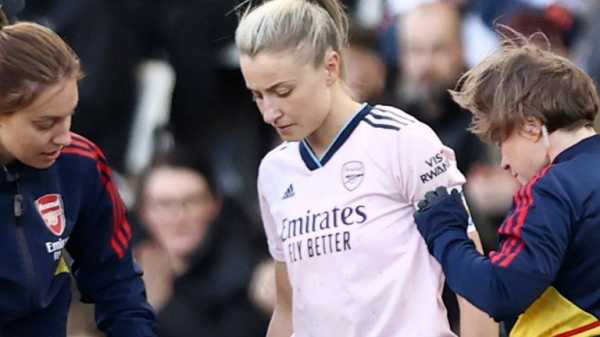
The ACL is one of the four main structural ligaments that control the stability of the knee. About the same thickness as your little finger, it runs inside the knee between the bottom of the thigh bone to the top of the shin bone. It’s particularly important in controlling pivoting and side-stepping movements when playing sports such as football, netball, rugby, and basketball.
Trending
- Transfer Centre LIVE! Man Utd begin attempts to prise Kane from Spurs
- Barca make Aubameyang top striker target | Firmino also on shortlist
- Ref Watch: Should Martinelli have been sent off? Leno back pass explained
- Spurs discussing Stellini future as interim head coach
- Carragher blasts ‘disgraceful’ Spurs | Dyer: Conte was right
- Nelson: Wilder ‘may fancy’ Bakole fight | ‘He’d put everybody else to shame’
- Saliba expected to miss Arsenal’s clash with Man City
- ACL injuries in women’s football Q&A: ‘We are way behind rest of the world’
- Papers: Chelsea squad excited by potential Pochettino arrival
- What does all-Manchester FA Cup final mean for PL’s European spots?
- Video
- Latest News
Within its tissue the ACL also has important receptors called proprioceptors that act as the communication between the brain and the knee, so the brain understands where the knee is and which muscles it needs to control its position with movement.
How is it torn?
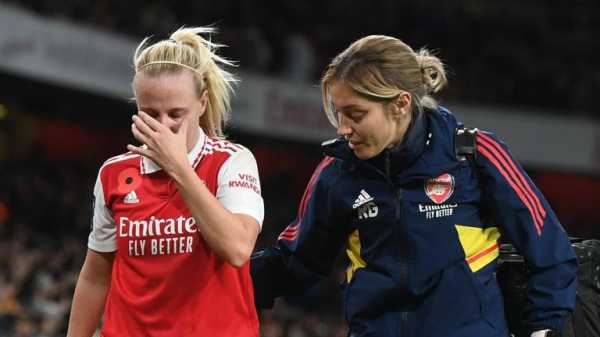
Sarina Wiegman says England striker Beth Mead is still rehabbing her ACL injury and would need a ‘miracle’ to be fit in time to play at the tournament
The majority of ACL tears or ruptures occur when the knee twists awkwardly – medically – we call this the pivot shift. It is usually when the lower part of the leg is planted, the knee is flexed and the pelvis and trunk over rotate. When this happens other structures such as the meniscal shock absorber cartilages and the joint surface cartilage is also at risk of being damaged.
Also See:
What is normally required for recovery & length of time to full recovery?

Everton forward Nico Sorensen talks to Izzy Christiansen about her difficult recovery from an ACL injury
An ACL rupture is a devastating injury for anyone of any age at any point in their sporting life. Almost all elite and professional athletes, who rupture their ACLs will have reconstructive surgery. This is usually done fairly soon after the injury and involves taking a graft of their own tissue either from the hamstrings or tendons around the knee and passing them across the knee, and secured either side in place of the original ACL.
It’s a keyhole technique and has been refined over the past 30 or so years. Then the hard work starts with the physios and rehabilitation. Patients use crutches, ice machines and muscle stimulators as the early phase of recovery looks to reduce swelling and recover range of movement.
Then the muscle strengthening starts with an exercise program over the coming months. I don’t let my patients return to contact sports for 12 months following the surgery – you certainly can’t rush the first six months, the healing phase, where the new graft integrates into the bone and gets supplied by new blood vessels.
Returning to sports too early increases a chance of a re-rupture so return to sports testing is the norm for professional athletes, whereby they are put through a series of assessments often comparing their non operated leg as a benchmark. Only when they hit certain goals would they be given the green light to return to match fitness.
So why are girls/women more at risk of ACL injuries than boys/men?

Image: Kyah Simon suffered an ACL injury in October, but why are they more common in women?
Perhaps the most interesting emerging evidence is that promoting inclusive and encouraging environments for girls can reduce the risk of injury, suggesting societal attitudes towards girls’ participation in sports need to continue to change.
The bottom line is girls playing more sports is a good thing along with that simple message there is a huge evidence base that injury prevention programs, such as PEPs, have proven effective in reducing the risk of ACL injury significantly in all athletes but with girls in non-contact situations benefiting the most.
The second reason is muscle strength differences, which are more noticeable in females, especially in the muscles controlling the knee, pelvis and trunk, are without doubt also significant risk factors. Importantly these are both modifiable risk factors which gives us the opportunity to influence this risk.
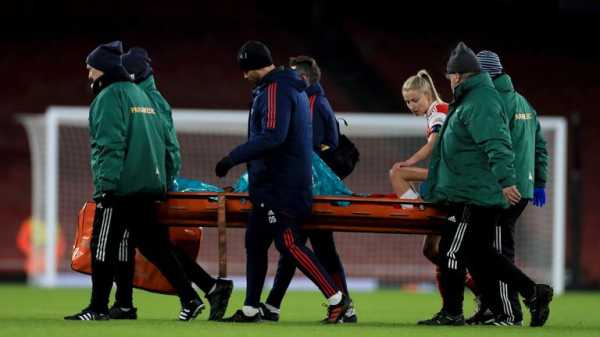
Image: Arsenal forward Vivianne Miedema is out for the season
More traditional factors such as anatomical differences in pelvis, leg shape between men and women actually play less of a role in ACL injuries than was originally thought.
Also, hormonal differences and the effect of the menstrual cycle perhaps have less of an impact on knee injuries than previously thought, but there is no doubt more research is needed around this.
Research in this field is complex, challenging and multifaceted, but there is this consistent narrative emerging that helps us understand how to mitigate risks associated with sport participation.
Initiatives such as the FA’s wildcats to introduce girls into football should be encouraged.
The recent news that girls will have equal time to boys for PE lessons in the UK national curriculum is also a positive step in the right direction.
Along with those we also need a generational shift in our knowledge and implementation of these simple injury prevention programs for all children and teenagers playing sport in the UK – we are way behind the rest of the world.
What can sportswomen do to mitigate potential ACL injury?
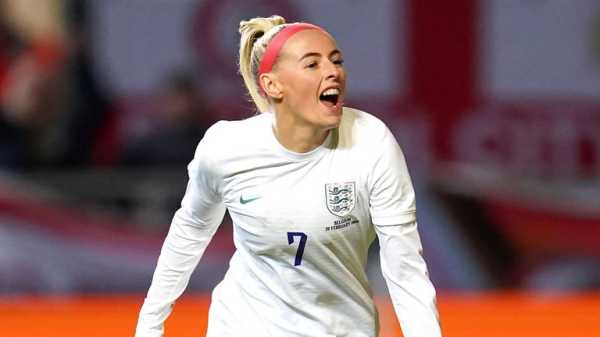
Image: Man City forward and Euro 2022 winner Chloe Kelly is one of the WSL players to have previously been sidelined with an ACL injury
Participating in ACL injury prevention programmes, which focus on strengthening exercises and teaching proper jumping and landing techniques, so landing with soft knees and keeping the knees in line with the toes, has been shown to reduce the risk of ACL injury in female football players.
Strengthening the muscles around the knee joint, such as the quadriceps, hamstrings, and glutes, on a regular basis can help to provide stability and support for the knee joint.
Proper warm-up and cool-down: Before and after training or matches, performing a dynamic warm-up and static stretching to improve flexibility and reduce the risk of injury.
They can also avoid overtraining, it’s critical to balance training and recovery to avoid fatigue and lower the risk of injury.
Could substandard pitches be impacting elite female footballers?
Personally I haven’t seen how different the women’s pitches are but in theory playing on subpar pitches with uneven surfaces, divots, or poor drainage can definitely increase the risk of injuries such as ankle sprains, knee injuries, and muscle strains.
There is some evidence that the negative psychological effect of playing on poor surfaces can cause frustration, demotivation and affect confidence and ability to perform.
Sourse: skysports.com
